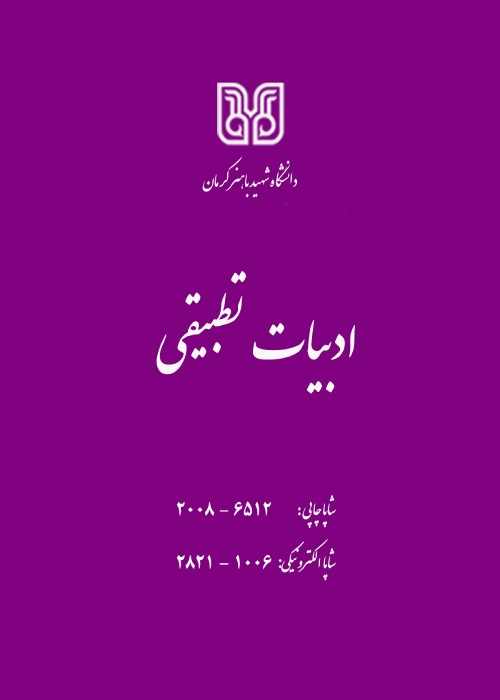Comparative Indian (Alankārā) and Islamic rhetoric
Author(s):
Article Type:
Research/Original Article (دارای رتبه معتبر)
Abstract:
Introduction
There was literature and poetry in Iran before Islam, and we have received works on this subject. However, nothing is left of the rhetorical works that probably written in those days. Hence, our information about them is limited to the remained references of some writers such as Al-Jahiz (776-868 AD), who reported the existence of a rhetorical writing in Pre-Islamic Iran called “Kārvand”. With the advent of Islam and doing the research on the mysteries of the eloquence and rhetoric of the Qur'an, the Islamic rhetoric formed by the efforts of muslims, in specific by Iranians. Over time, the Iranians also wrote books on rhetoric in Persian. In terms of content, these books were influenced by Arabic rhetorical books and they rarely discloed new concmepts. From the 16th to 18th centuries, in the eara Safavids and Gurkhanids imperia (Great Mongol Empire), along with other rhetorical currents, a new rhetorical current formed. It was appeared through the adaptation of Indian (Alankārā) and Islamic rhetoric. In this process, aesthetic, rhythm, and recognizing the beloved in Indian poetry issues have been translated into Arabic and Persian. Also, the evidence from Arabic and Persian poetry has been presented for them.
Methodology
This study is based on the analytic-descriptive method by using library research. The works which have been written in Persian and Arabic with the subject of comparision of Indian rhetoric with Islamic rhetoric during the 16th to 18th centuries are presented in the current investigation. After that, the presented issues in these books are considered by focus on the proposed issues in the Islamic rhetoric and the similarities and differences are analyzed.
Discussion
From the sixteenth to the middle of the eighteenth century, rhetorical works written in Arabic do not include the new subjects.
In these centuries, "looking at the books of the past and trying to teach, learn and finally annotate and possibly describe or summarize them" is common (Safa, 1999, V5/1: 414). This issue paved the way and it is closed to any innovations. The most prominent Persian rhetorical books, such as Dastour al-Shoarā by Mohammad Mazandarani, nicknamed Amani (d. 1682) and informed by Razi al-Din Muhammad ibn Muhammad Shafi'i, written in 1684 AD also contains the same subjects and elements that has already been seen in Arabic and Persian rhetorical books.
Among the currents that exist in the 16th to 18th centuries in the field of rhetorical writings and research in Iran and India in the Safavids and Gurkhanids (Great Mongol Empire), there is a new current:the comparative reading of Indian rhetoric, known as "Alankārā", with Islamic rhetoric and translation of issues of Indian prose and rhyme, aesthetics of Indian poetry and knowledge of Indian lover in Arabic and Persian and finding the evidence of Arabic and Persian literature for these. This current has two prominent faces:- Mirza khan Ibn Fakhr Ol-din Muhammad, author of the Tohfat Ol-Hend (1068-1118 AH).
- Mir Gholam Ali Azad Hosseini Waseti Belgerami (1116-1200 AH) Author of Sebhat Ol-Marjan fi Asar Ol-Hendestan (1177 AH) and Ghezlan Ol-Hend (1178 AH).
Tohfat Ol-Hend was written during the time of Aurangzeb and apparently for Muhammad Azam, his third son. This prince was interested in Indian wisdom, art, and literature, and poets such as Bidel Dehlavi, Rasekh Serhendi, and Salem Keshmiri were associated with his court. Tohfat Ol-Hend has seven chapters, all of which are very valuable in terms of identifying Indian culture and literature. Sebhat Ol-Marjan fi Asar Ol-Hendestan is the first book of Azad Belgerami about comparative rhetoric and has four chapters. The third chapter of the Sebhat Ol-Marjan is a separate treatise on comparative Indian and Islamic rhetoric. The fourth chapter is also very useful for research in the comparative aesthetics of the beloved in Arabic and Indian poetry. Ghezlan Ol-Hend is also a summary of Sebhat Ol-Marjan and Is Written in Persian. The author of these two books, Azād Belgerami, Was Known as literate in his time. As Khan Arezou called him a "scientist and wise man" (Arezou, 2005: 42) and praised his poetry.
In comparing Indian rhetoric with Islamic rhetoric, notable issues are:
In Indian and Islamic rhetoric, simile has a special place. Of course, the simile in Indian and Islamic rhetoric is not exactly the same. For example, Arab scholars have divided the simile according to its sides, whether it is sensory or rational (Non-sensory) or different, and Indian literature has a different opinion (Azād Al-Belkerami, 2015: 231). Some of similies in Indian rhetoric have equivalent in the Islamic rhetoric. On the one hand, in Indian rhetoric, the categorize of similies are based on the concepts of verses. In light of this prespective, there could be possible to innovate a large number of similies.
In Indian and Islamic rhetoric, literary ornaments can also be compared; we see two groups of literary elements and ornaments in the comparative works of Indian and Islamic rhetoric:
In most cases, the literary ornaments are the abstract of verse concepts and in fact is a title for them.
Those that have existed in the Indian rhetoric from the beginning and those that have been created by the authors of those works. Literary ornaments in Indian rhetoric are often the summary of the content of the verses and the title for them. For example:Al-Tosie (Order)
The narrator orders the person who fulfills her wish after death. In Indian rhetoric, there is a section called “Naika Behid” (Beloved Science) or knowing the types of Beloved. In Indian culture, "Naika" means "woman" and "Naik" means "man". "Behid", like the words "Veda" and "Wid", means "knowledge". We do not have such a thing in Islamic rhetoric. Among the Persian rhetorical works, the only work that is somewhat compatible with “Naika Behid” is Anis Ol-oshaq (757 AH) by Sharaf Ol-Din Rāmi. The author Has Said that "poets have divided the beloved from head to toe in nineteen sections" (Rami, 1946: 3). Based on this view, he has examined the descriptions of the beauty of the beloved in nineteen sections and has given examples of Persian poetry for each. In Naika Behid, as in Indian Alankārā, the tendency is towards content issues and not towards formal and physical issues. In translating this art into Arabic and Persian, Indian writers have divided women into different types according to their moral and spiritual characteristics, age, treatment of friends etc.
Conclusion
One of the anonymous currents in the formation of Islamic rhetoric is the current that formed by creating an interaction between Indian with Arabic and Persian culture and literature in the Safavid (Timurid) period. This current is the adaptation of Indian rhetoric (AlNakārā) with Islamic rhetoric. In fact, it is the translation of rhetorical and expressive issues from Hindi to Arabic and Persian. The approach is as follows: after defining an Indian rhetoric to Arabic and Persian languages, they are given evidence of poetry in both languages. This movement has done by two famous literate including Mirza khan Ibn Fakhr Ol-din Muhammad and Mir Gholam Ali Azad Belgerami.
By comparative looking at ndian and Islamic rhetoric, we conclude that:
Some rhetorical beauties and ornaments are specific to Islamic rhetoric. However, some are specific to Indian rhetoric and some are common in both of them. Ferthermroe, sometimes the same Indian beauties and ornaments are not without equivalents in Islamic rhetoric. There are also topics that have not been discussed in Islamic rhetoric, but some types of verses can be used for aesthetic analysis.
In comparing Indian and Islamic rhetoric, it can be seen that Indian aesthetics is mainly concerned on the content issues of the verses rather than the formal and verbal issues.
Indian rhetoric also has a chapter called “Naika Behid”, which can be called women's science or knowing the beloved. In this field, based on the content orientation of the poems, the beloved of poem from the prespective of sensual characteristics, age, and the way of behave with a friend are named and categorized. In translating Naika Behid into Arabic and Persian, due to social and cultural differences, it is necessary to make changes in the position of “Naika” and the gender of the beloved.
Keywords:
Language:
Persian
Published:
Journal of Comparative Literature, Volume:13 Issue: 25, 2022
Pages:
209 to 229
magiran.com/p2400860
دانلود و مطالعه متن این مقاله با یکی از روشهای زیر امکان پذیر است:
اشتراک شخصی
با عضویت و پرداخت آنلاین حق اشتراک یکساله به مبلغ 1,390,000ريال میتوانید 70 عنوان مطلب دانلود کنید!
اشتراک سازمانی
به کتابخانه دانشگاه یا محل کار خود پیشنهاد کنید تا اشتراک سازمانی این پایگاه را برای دسترسی نامحدود همه کاربران به متن مطالب تهیه نمایند!
توجه!
- حق عضویت دریافتی صرف حمایت از نشریات عضو و نگهداری، تکمیل و توسعه مگیران میشود.
- پرداخت حق اشتراک و دانلود مقالات اجازه بازنشر آن در سایر رسانههای چاپی و دیجیتال را به کاربر نمیدهد.
In order to view content subscription is required
Personal subscription
Subscribe magiran.com for 70 € euros via PayPal and download 70 articles during a year.
Organization subscription
Please contact us to subscribe your university or library for unlimited access!



